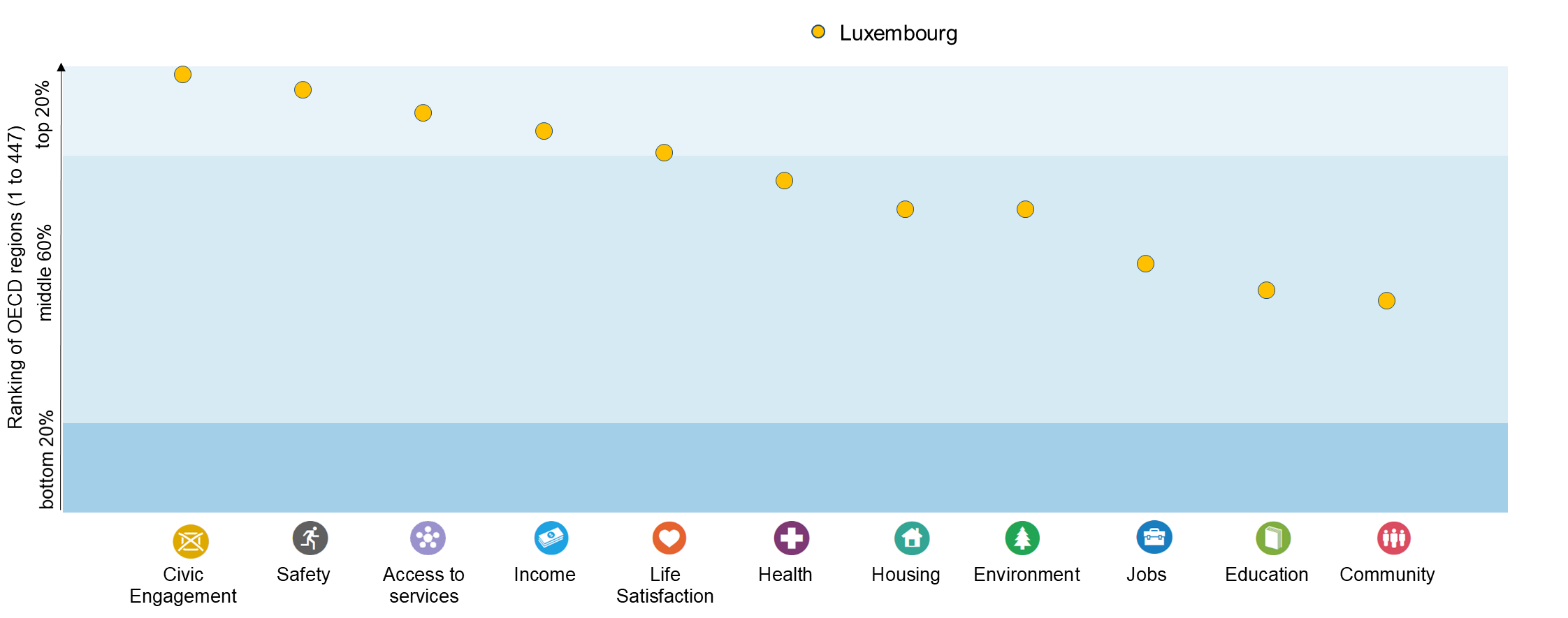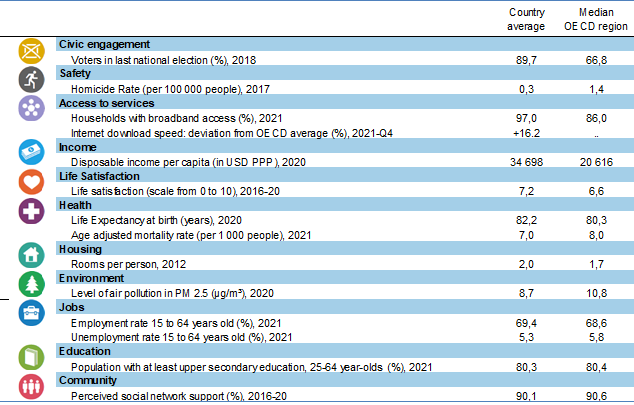Luxembourg
The data in this note reflect different sub-national geographic levels in OECD countries:
Regions are classified on two territorial levels reflecting the administrative organisation of countries: large regions (TL2) and small regions (TL3). Small regions are classified according to their access to metropolitan areas (Fadic et al. 2019).
Functional urban areas consist of cities – defined as densely populated local units with at least 50 000 inhabitants – and adjacent local units connected to the city (commuting zones) in terms of commuting flows (Dijkstra, Poelman, and Veneri 2019). Metropolitan areas refer to functional urban areas above 250 000 inhabitants.
In addition, some indicators use the degree of urbanisation classification (OECD et al. 2021), which defines three types of areas:
- Cities consist of contiguous grid cells that have a density of at least 1 500 inhabitants per km2 or are at least 50% built up, with a population of at least 50 000.
- Towns and semi-dense areas consist of contiguous grid cells with a density of at least 300 inhabitants per km2 and are at least 3% built up, with a total population of at least 5 000.
- Rural areas are cells that do not belong to a city or a town and semi-dense area. Most of these have a density below 300 inhabitants per km2.
Disclaimer: https://oecdcode.org/disclaimers/territories.html
Well-being, liveability and inclusion in regions
Regional well-being
Luxembourg performs above the OECD median region in nine out of eleven well-being dimensions, particularly in terms of civic engagement, safety, access to services and income.

Note: Regional indices provide a first comparative glance of well-being in OECD regions. The figure shows the relative ranking of the regions with the best and worst outcomes in the eleven well-being dimensions, relative to all OECD regions. The eleven dimensions are ordered by decreasing regional disparities in the country. Each well-being dimension is measured by the indicators in the table below.
In terms of well-being indicators, Luxembourg does particularly well in voter turnout, ranking among the top 10 OECD regions in terms of the share of voters casting a ballot in the last national election.

Note: Regional well-being indices are affected by the availability and comparability of regional data across OECD countries. The indicators used to create the indices can therefore vary across OECD publications as new information becomes available. For more visuals, visit https://www.oecdregionalwellbeing.org.
The digital divide
Fixed Internet connections in Luxembourgish cities and rural areas deliver speeds significantly faster than the OECD average (46% and 7%, respectively). This gap (39 percentage points) is smaller than in most other OECD countries.
Note: Cities and rural areas are identified according to the degree of urbanisation (OECD et al. 2021). Internet speed measurements are based on speed tests performed by users around the globe via the Ookla Speedtest platform. As such, data may be subject to testing biases (e.g. fast connections being tested more frequently), or to strategic testing by ISPs in specific markets to boost averages. For a more comprehensive picture of Internet quality and connectivity across places, see OECD (2022), “Broadband networks of the future”.
Source: OECD calculations based on Speedtest by Ookla Global Fixed and Mobile Network Performance Maps for 2020Q4.
Demographic trends in regions and cities
Population projections by type of regions across OECD countries
Luxembourg will see its population increase by 18 % over the next two decades. This rate is among the highest in OECD metropolitan regions.
Note: Lines represent the population projection in OECD countries per type of region (Fadic et al. 2019). Luxembourg is highlighted in blue.
Proportion of the elderly
In the coming two decades, Luxembourg will see its elderly population increase from 15% to 22%. This share will remain low compared to other OECD metropolitan regions.
Population in cities
Between 2010 and 2021, Luxembourg experienced a rise in population averaging 2.2% per year.
Environmental challenges in regions and cities
Urban heat island effect
In Luxembourg, the difference in temperature between the city and its surrounding areas (i.e. urban heat island intensity) reaches on average 3.7 degrees Celsius (°C).
Note: The Urban Heat Island Intensity (UHI) index is defined as the difference in land surface temperature between built-up areas and non-built-up areas within functional urban areas. This index can be affected by the type of vegetation and climate in non-built-up areas.
Source: OECD calculations, based on land surface temperature data from NASA’s Moderate Resolution Imaging Spectroradiometer (MODIS) (Wan, Hook, and Hulley 2021a, 2021b)
References
Source of administrative boundaries: © OECD, © EuroGeographics, National Statistical Offices, © UN-FAO Global Administrative Unit Layers (GAUL)
